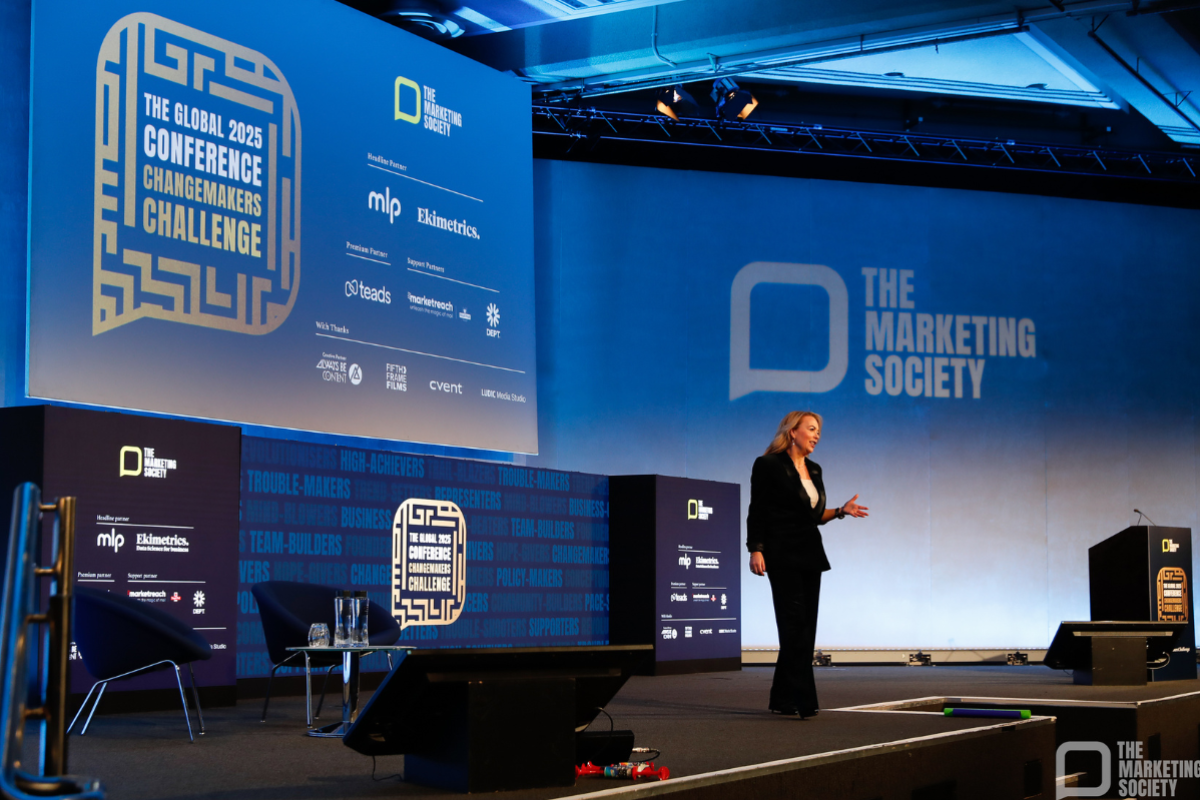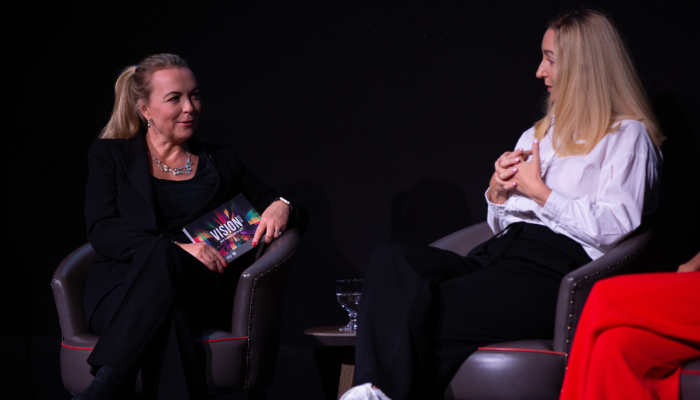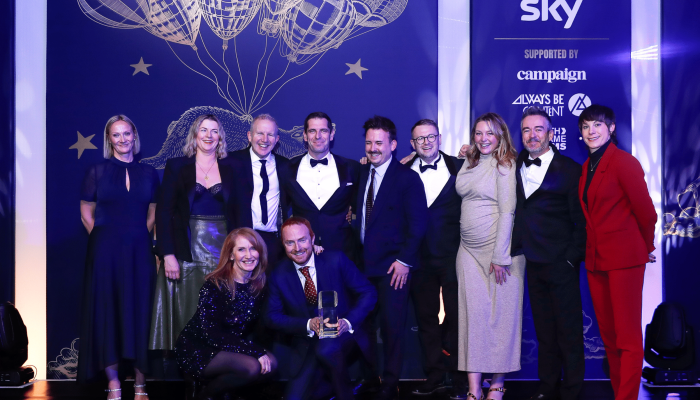The final Changemakers Conference of 2025 brought together 500+ marketing leaders at London's QEII Conference Centre to explore how challenge fuels opportunity. From Dame Carolyn McCall's call for marketers to claim their seat at the top table, to Zak Brown's McLaren turnaround story, to Professor Green's honest conversation about masculinity, the day proved that marketing at its best connects commercial realism with real human lives. This was a masterclass in turning pressure into progress.
Five Key Points
Marketing Must Earn Its Strategic Seat
The gap between marketing departments and leadership teams is widening. CEOs want marketers who understand commercial realities, bring customer insights with intelligent action, and drive growth conversations. Stop speaking in marketing terms. Start speaking the language of business.
Challenge is a Deliberate Choice
The best leaders don't just respond to challenge, they create it. They push teams to experiment boldly, turn insights into action, and recognise that letting go of what worked five years ago is how you stay ahead. McLaren's championship came down to seven-tenths of a second in a pit stop after 24 weeks of racing. That's why complacency kills.
Human Connection Beats Technology
In a world where Gen AI transforms work at lightning speed, your competitive advantage is fundamentally human. Joy breaks down barriers. Authenticity builds trust. Community creates currency. From Who Gives A Crap's toilet paper revolution to M&S turning 70,000 colleagues into brand ambassadors, the brands winning are those prioritising genuine human connection over digital reach.
Community is Built, Not Bought
Whether building brands, driving social change, or tackling mental health, power lies in community. GymShark succeeded because 95% of their narrative came from their community, not owned channels. Comic Relief raised £1.6 billion over 40 years by embedding joy into culture. Bijou de Mimi created unboxing experiences so special that 90% of recipients post organically to hundreds of thousands of followers.
Purpose Requires Authentic Action
Values-based marketing rings hollow without substance. The brands gaining loyalty are those where purpose drives every decision. Yinka Ilori embeds Nigerian folklore into playground designs. National Youth Orchestra removed audition barriers to reach 1,000 state school teenagers annually. Purpose works when it's lived, not marketed.
The State of Play
Sophie Devonshire opened by positioning marketers as Zeitgeist navigators, stepping into the unknown each week as the world shifts rapidly. Lord Gavin Barwell delivered sobering geopolitical analysis: eight mega-trends are creating a poly-crisis where once-in-a-generation events now happen with increasing regularity. Multi-polarity, big power competition, climate change, technology disruption, and populism aren't separate challenges but interconnected forces amplifying each other. Trump is both effect and cause. UK politics has fundamentally fractured. Brexit sentiment widens generationally. The message: build resilience for the unforeseeable because nobody can predict everything.
Marketing's Leadership Challenge
Dame Carolyn McCall used her Presidential Address to challenge marketers directly. She'd spoken with fellow CEOs about what they actually want from marketing teams. The gap between expectations and reality was stark. CEOs want real-world insight into what customers think AND feel, with intelligent insight that drives decisions. They want marketers who understand commercial realities, can demonstrate long-term value whilst being tactical when numbers aren't working, and who act as bridges helping everyone understand the tangible benefits of a healthy brand. Her challenge: lead the conversation about how marketing impacts business growth. Claim your seat at the top table.
Building Brands That Matter
Amelia Hitchcock-Merritt built Bijou de Mimi from her bedroom during lockdown into a multi-million pound jewellery phenomenon by being her own customer. Treating the brand like an A-level art project with social media as her sketchbook created transparency that allowed customers to grow with her. The unboxing experience became so special that 90% of gift recipients post organically. The Kings Road pop-up that attracted 3,000 teenage girls and caused "carnage" taught more about community than years of steady growth.
Yinka Ilori demonstrated how joy isn't frivolous but essential. His colourful playgrounds, chairs embedded with Nigerian folklore, and brand collaborations prove that design can empower communities whilst driving commercial success. Growing up on a council estate shaped his belief that community must be central, not an afterthought.
Emily Kraftman shared how Who Gives A Crap disrupted toilet paper by making purpose the greatest loyalty lever. Their donation message is what customers share most. Sales spike on days they announce impact updates. When their first production run had no perforations, they fronted it up, apologised, and asked for forgiveness. The vast majority came back and became their most loyal customers.
Technology as Partner, Not Threat
Jeremy Connell-Waite challenged the doom narrative around AI. Research proves that just 3.5% of any population can influence everyone else to change. The 500 people in the room could reach 14 million with the right message and tools. He uses AI not to write emails but as a coach, critical thinking assistant, and creative collaborator. The breakthrough: stop thinking "AI will take my job" and start thinking "IA will help me do my job better."
The Power of People
Sharry Cramond revealed M&S's transformation from "burning platform" in 2017 to UK's favourite brand in 2025. The secret: turning 70,000 colleagues into brand ambassadors. Marketers have three jobs - drive trade, build the brand, AND engage colleagues. That third responsibility is often forgotten but might be most important. M&S enabled 600 stores to run social media accounts, created an insider programme reaching 25 million people, and never approved content in advance because they trust colleagues every day to speak face-to-face with customers.
Elfried Samba explained why GymShark succeeded: only 5% of their narrative came from owned accounts. 95% came from their community. Most brands spend 95% of their voice talking about themselves. Trust is built when others talk about you, not when you talk about yourself. In an AI-enabled world, emotional intelligence beats technology.
Leading with Humanity
Zak Brown took McLaren Racing from bottom of Formula 1 to World Constructors Champions by serving his team rather than leading them. The secret sauce was people, culture, and stability. Creating a high-performance culture where 1,400 people focus on incremental gains daily. After winning races, they start by discussing what could be improved. The Constructor's Championship came down to seven-tenths of a second in the final pit stop after 24 weeks of racing.
Ashley Wray demonstrated that 60 seconds of mindfulness before critical moments transforms decision-making and leadership presence. Ariana Huffington repeatedly said her most expensive mistakes at Huffington Post came from making decisions under stress. Self-awareness drives compassion. The compassionate internal voice becomes your external voice.
Professor Green (Stephen Manderson) brought raw honesty about masculinity and mental health. Boys develop executive function more slowly than girls and need more support. Harmful phrases like "boys will be boys" create harmful expectations. Young men need better role models who help navigate anger productively, not feed it.
Community and Cultural Relevance
Sir Lenny Henry and Samir Patel celebrated Comic Relief's 40 years and £1.6 billion raised. Comedy breaks down barriers because when something is funny, people relax. They embedded themselves into school curriculum early, creating lifelong supporters. The challenge now: staying culturally relevant in a fragmented media landscape.
Richard Curtis and Samir ran an interactive workshop where the room generated 83 ideas. The best were simple enough for anyone to do, had clear giving mechanisms, and transformed everyday activities into joyful fundraising moments.
Sarah Alexander shared how National Youth Orchestra transformed from elite institution to accessible movement reaching 1,000 state school teenagers annually. They removed auditions and reframed around what teenagers actually want: making friends, having fun, and being part of something electric. Role models from the NYO perform in schools, changing the algorithm from "prestigious tradition" to "I want to be in that gang."
Three Takeaways
Bridge the Gap Between Marketing and Leadership
Stop sitting in a bubble of creativity and external partnerships. Understand what's really happening at board level. Speak the language of business, not marketing terms. Bring customer voice to every strategic decision. Demonstrate long-term value delivery using metrics the entire business understands.
Make Your People Your Marketing
Your colleagues, your customers, your community are more powerful than any campaign. Enable employee advocacy at scale. Create experiences so remarkable that customers become your marketers organically. Aim for 95% of your brand narrative to come from others, not your owned channels.
Lead with Purpose and Joy
In fragmented, challenging times, joy isn't frivolous and purpose isn't optional. They're competitive advantages. But only when authentic. Live your values through every decision. Take causes seriously without taking yourself too seriously. Human connection beats technology every time.
Two Action Items
to take from this
Audit Where Your Voice Comes From
Map what percentage of your brand narrative comes from owned channels versus customers and community talking about you. If you're above 50% owned content, you're broadcasting rather than building community. Create mechanisms for customers to share their experiences authentically.
Claim Your Seat at the Strategic Table
Schedule time with your CEO or leadership team specifically to discuss how marketing drives growth, not just marketing activity. Bring customer insights, commercial understanding, and clear connections between brand health and profitability. Challenge the view that marketing sits on the side lines.

"Your biggest challenges are actually your greatest opportunities."
Sophie Devonshire



